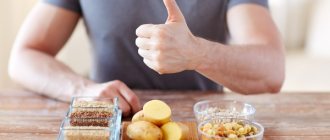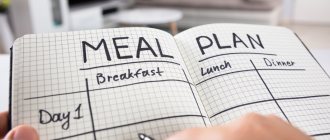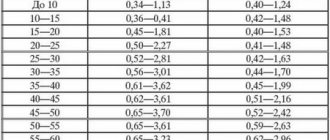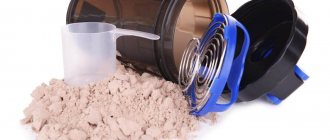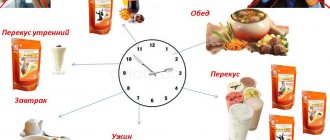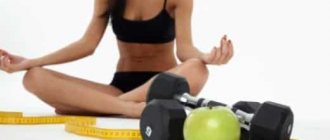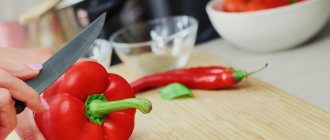Individual nutrition plan for a bodybuilder[edit | edit code]
As your weight changes, you must recalculate the amount of energy and nutrients you need. With the help of Body Expert, you will receive information on calorie needs, this is a necessary condition that allows you to create the correct nutrition for a bodybuilder for an individual, taking into account the individual parameters of the body.
Bodybuilder nutrition to maintain muscle mass.
Men who exercise five or more times per week need to consume 42 calories per kilogram of body weight per day (3,444 calories per day for an 82-kg man). Women who exercise five or more times per week will be able to increase muscle mass by consuming 44 to 50 calories per pound of body weight per day (2,950 calories per day for a 59-kg woman) and maintain muscle mass by consuming approximately 38 to 40 calories per day. kilogram of body weight per day (2360 calories). The larger and more muscular a woman is, the more calories she should consume to maintain her muscles.
Petite women may need less than 38 calories per kilogram of body weight per day to maintain muscle mass. For women, you learn a lot by trial and error, since all scientific experiments were done on men, and activity levels can vary greatly between individuals. For other parts of the nutrition plan, women should generally choose smaller portions. This diet is great for bodybuilders, weightlifters, powerlifters, and amateur strength athletes. Beginners must follow special instructions.
Nutrition for building muscles and gaining mass
. This plan requires consuming 44-52 calories or more per kilogram of body weight per day, depending on the intensity of the activity (4264 calories or more for a man weighing 82 kg); 2596-2950 calories for a 59 kg woman. Start with a minimal amount and add calories as needed. As noted earlier, for women looking to build muscle, 44 calories per kilogram of body weight per day will be enough. Petite women should consume slightly fewer calories at the beginning of a workout program and add more as their muscle size increases. This diet is suitable for all competitive strength athletes and amateurs. Beginners must follow specific beginner instructions.
Diet for terrain
(10-12 weeks of pre-competition diet). In order to reduce the fat component and start working on muscle definition, you should consume 35-38 calories per kilogram of body weight per day (3116 calories for a man weighing 82 kg; 2065 calories for a woman weighing 59 kg). Because it is more difficult for women to lose fat than men, they should consume a minimum amount of calories and increase aerobic activity to burn 300-400 calories per day. Again, petite women will require fewer calories. This recommendation applies mainly to female bodybuilders. Beginners follow the instructions for beginners.
Fat Burning
(maximum 7-14 days). This plan calls for consuming 29 calories per kilogram of body weight per day for women (1,711 calories for a 59-kg woman) and 32 calories per kilogram of body weight per day for men (2,624 calories for a 82-kg man). For smaller women following a reduced-calorie diet, this may also include reducing the number of recommended calories. Use this method only in extreme cases. This diet is only suitable for bodybuilders or competitive athletes gaining pounds for their weight class, but not for powerlifters (strength lifters) or Olympic weightlifters.
Powerlifters and weightlifters
gaining muscle mass for their weight category. Once you've followed a muscle-building diet, you'll need to go back to a maintenance diet for two weeks before you get into shape. This diet will allow you to get rid of subcutaneous fat without losing muscle mass, strength and endurance. This technique is also a good basic diet for high-impact strength athletes who are trying to lose subcutaneous fat.
Calculate your protein needs[edit | edit code]
Calculation of protein needs
Protein requirements vary depending on energy intake and exercise goals. Although menu plans presented in foreign articles give food volumes in grams per pound of body weight, you can easily convert kilograms to pounds by multiplying your weight by 2.2. Make sure your body is getting the amount of protein it needs by following all four bodybuilding nutrition strategies. If you're vegan, add an extra 10% protein to each plan.
- Maintenance of muscle mass: 1.4 g per kilogram of body weight per day.
- Muscle building: 3.5-4 g per kilogram of body weight per day.
- Nutrition for relief: 2.2 g per kilogram of body weight per day.
- Fat burning: 2.3 g per kilogram of body weight per day (2.2 for those who prefer mainly vegetarian dishes).
Bodybuilder Diet Results
Weight loss and the appearance of muscle relief will begin only after a month of constant adherence to the training and nutrition regimen. And this is not a fact! You often have to wait 10-12 weeks for the first results, but if they appear, then the further transformation of your appearance will be quick and only in the desired direction.
It is worth knowing that you will be able to achieve your goal only if all the rules are strictly followed - no concessions, holidays or weekends. Exiting a bodybuilder's diet should be gradual and intelligent - you cannot immediately include fatty and fried foods in the menu, because serious problems may arise in the functioning of the gastrointestinal tract.
A bodybuilder's diet does not mean that losing weight will be accompanied by aggressive muscle building. On the contrary, the body will only acquire a beautiful relief and become slender and toned. A pleasant addition will be strengthening the immune system, stabilizing the psycho-emotional background and overall health.
Calculate your carbohydrate needs[edit | edit code]
- Carbohydrates
- Energy bars
- Carbohydrates before workout
- Carbohydrates after exercise
- Carbohydrate loading
Calculate your carbohydrate needs based on a ratio of 5-7 g per kilogram of body weight per day. Strength athletes need 5-6 g per kilogram of body weight per day to maintain shape and 6.5-7 g per kilogram of body weight per day to build muscle. Athletes involved in ultra-intensity sports like Ironman need 8-10 grams per kilogram of body weight per day. Beginners should consume a lower amount of carbohydrates at all levels of training, but this amount will increase as the intensity of the workout increases.
During the fat reduction and fat burning stages, women and men require different amounts of carbohydrates. Below are the required carbohydrate doses per kilogram of body weight per day.
- Nutrition for relief
Women: 2.5-3.5 grams per kilogram - Men: 3-4 grams per kilogram
- Women: 1.8–2.9 grams per kilogram
Calculate your fat needs[edit | edit code]
The remaining calories will be 25-30% of the total. Fat sources should be primarily monounsaturated and polyunsaturated fats, including omega-3 fatty acids with much less saturated fat.
To determine the amount of fat you need in grams, first determine the number of calories contained in the doses of protein and carbohydrates that your body requires, which you should have already calculated earlier (1 g protein = 4 calories; 1 g carbohydrates = 4 calories). Now subtract these calories from the total calories needed for a particular bodybuilding phase of nutrition and exercise, and you will get the number of fat calories you require. Fat contains 9 calories per gram. So if you divide the calories of fat by 9, you get the grams of fat you need.
Grocery list
Bodybuilders have a very wide range of food products. They can easily include in the menu:
- Meat – beef or chicken and other poultry. Prepared by steaming, in a pan or in the oven.
- Fermented milk products. Strict control of fat content is necessary. It should be minimal. Low-fat cottage cheese should be consumed in the body in a volume of at least 400 grams per day.
- Various porridges, such as buckwheat, rice, oatmeal, are prepared with meat.
- 3 eggs a day. Pure protein can be consumed in unlimited quantities.
- Fatty fish. It is recommended to eat it as much as you like. Nutritionists also recommend drinking additional fish oil.
Cooking any food requires minimal use of oil. Products must be dietary and natural. Source: abgym.ru
Products for weight gain
Pre- and post-workout foods for bulking should be high in starchy carbohydrates but low in fat. It will make you stronger and provide you with the energy to support muscle growth. Proper nutrition for jocks who are training to gain mass should include more of these dishes in their daily diet.
In between workouts, you should limit the amount of starchy carbohydrates and focus on fats. This way you will speed up the fat burning process.
Food sources of starchy carbohydrates:
- Starchy foods: brown rice, quinoa, potatoes, oatmeal, whole grain pasta, baked goods, cereals, cereals.
- Protein products: protein powder, egg white, whole eggs (dosed), lean meat, white fish, Greek yogurt.
- Fruits, vegetables and legumes: exotic fruits, green or fibrous vegetables, legumes.
- Vegetable oil: use sparingly, a teaspoon instead of a tablespoon.
Starch-free food is prepared from:
- Protein foods: protein powder, eggs, white and red meat, fatty or white fish, Greek yogurt.
- Fruits, vegetables and legumes: berries, green or fibrous vegetables, beans (in small quantities).
- Vegetable oil or fat: measure with a tablespoon instead of a teaspoon. Avocado, seeds and nuts, coconut oil, canola mayonnaise, full-fat cheese.
Products for drying
“Drying” will only happen if you eat the right food, which should be predominantly protein. However, for better protein absorption and normal digestion, athletes’ menus should also include fiber in the form of vegetables and grains.
In addition, professional bodybuilders dry with the obligatory intake of sports nutrition - protein and amino acids, from which they can obtain the amount of proteins necessary to preserve muscles.
Consumption of the following products during weight loss is prohibited:
- refined oil;
- fatty dairy products;
- margarine;
- smoked meats;
- fried foods;
- canned food;
- sweets;
- starchy vegetables and legumes;
- flour products.
Since it is impossible to completely avoid unsaturated fats (they play a very important role for the body), those who are dry can get them from olive oil, nuts, and red fish.
On a sports diet, athletes are allowed to eat:
- sour fruits;
- green vegetables;
- milk (no more than 100 ml per day);
- boiled eggs;
- chicken meat without skin, fat;
- low-fat kefir, cottage cheese;
- mushrooms (once a week);
- lean fish, baked or boiled;
- green tea, mineral water.
Source: allslim.ru
Diet for a beginner
Norm: 2500 Kcal, 218 g carbohydrates, 218 g protein, 83 g fat.
If you want to improve your shape and become more energetic in training, this option will be the most optimal. It limits carbohydrate intake from food and sets a high level of protein intake.
It focuses on foods with antioxidant properties that can improve the condition of blood vessels and prevent inflammatory processes - these two factors activate the aging process of cells.
Meal schedule.
- Dish 1: Starchy-carbohydrate
- Meal 2: Low/no carb
- Meal 3: Low/no carb
- Meal 4: (Post-workout snack) Starchy-carbohydrate
- Dish 5: Starchy-carbohydrate
Recommended recipes.
Dish 1
- Greek yogurt - one and a half cups (tbsp.)
- Raspberries – 1/2 tbsp.
- Muesli (vanilla, almond, or without fillers) – 1/3 tbsp.
- Eggs (source of Omega-3) – 3 pcs.
Dish 2: Double chocolate smoothie with cherries.
- Protein powder (chocolate flavor) – 2 servings
- Coconut milk – 1/4 tbsp.
- Cherries – 3/4 tbsp.
- Flax seeds – 1 tablespoon (tbsp.)
- Cocoa powder – 1 tbsp. l.
- Ice – 3–4 pieces
- Water – 2–3 tbsp.
Dish 3: Burger with lettuce.
- Lettuce – 2 sheets
- Ground beef (5% fat) – 227 g
- Tomatoes – 2 rings
- Red onion – 2 slices
- Ketchup – 1 tbsp. l.
- Mayonnaise (canola) – 1 tbsp. l.
- Green beans – 3 tbsp.
Meal 4: Post-workout snack: protein bars (recovery drink) – 1 serving.
Dish 5: Shrimp with spinach salad and a side dish of brown rice.
- Shrimp – 170 g
- Brown rice - 1/4 tbsp.
- Spinach – 4 tbsp.
- Feta cheese – 1/4 tbsp.
- Half paprika
- Olive oil (Extra virgin) – 2 tbsp. l.
- Raspberry substitutes: 5 chopped strawberries, 1/2 tbsp. blueberries, 2/3 tbsp. blackberries or 1 tbsp. l. raisins
- Instead of muesli: 1/3 tbsp. oatmeal or rolled oatmeal flakes, 3/4 tbsp. breakfast cereal Fiber One or 2/3 tbsp. organic flakes.
- Coconut milk alternative: 2 tbsp. l. chopped walnuts.
- Cherries are replaced: 1 tbsp. blackberries.
Note: A “post-workout snack” refers to a shake or meal rich in quickly digested carbohydrates.
Fat burning diet
Norm: 2000 Kcal, 150 g carbohydrates, 150 g protein, 88 g fat.
You can speed up fat burning by reducing your intake of starchy carbohydrates. You can eat them once - immediately after completing strength training. This diet option suggests focusing on leafy greens and vegetables - this is a convenient method of reducing calories and cutting carbohydrates.
It is recommended to lean on fats so that the body begins to utilize them instead of carbohydrates when producing energy (a clever trick from the professionals for breaking down fat instead of muscles).
Meal schedule.
- Meal 1: Low/no carb
- Meal 2: Low/no carb
- Meal 3: Low/no carb
- Meal 4: (Post-workout snack) Starchy-carbohydrate
- Dish 5: Starchy-carbohydrate
Recommended recipes.
Dish 1: Omelet with spinach.
- Eggs – 3
- Cheese (Pepper Jack) – 1 slice
- Spinach (baby) – 1 tbsp.
- Peaches – 1 piece
Dish 2: Nut-chocolate shake.
- Protein powder (chocolate flavor) – 1 serving
- Chocolate milk – 2 tbsp.
- Peanut butter – 2 tbsp. l.
- Chia seeds – 1 tbsp. l.
- Ice – 2–3 pieces
Dish 3 (similar): Creamy-strawberry smoothie.
- Protein powder (vanilla flavor) – 1 serving
- Flax seeds – 1 tbsp. l.
- Strawberries – 6 pcs
- Yogurt – 3/4 tbsp.
Dish 4: Grilled steak with tomato and avocado salad.
- Steak (from the pulp of the upper part of the beef thigh) – 113 g
- Half an avocado
- Tomatoes – 1 piece
Meal 5: Post-Workout Snack:
- Protein powder (recovery drink containing 50 g carbohydrates and 25 g protein) - 1 serving.
Dish 6: Flax paste with a hearty sauce.
- Chicken (diced chicken breast fillet) – 85 g
- Whole grain flax paste – 28 g
- Mushrooms (slices) – 1 tbsp.
- Broccoli flowers – 2 tbsp.
- Marinara sauce – 1/2 tbsp.
- Olive oil (Extra virgin) – 1 tbsp. l.
- Salad recipe No. 1: 3 tbsp. cabbage and broccoli mix and 2 tbsp. l. dressing for coleslaw.
- Salad recipe No. 2: 1/2 tbsp. roasted edamame beans and 2 tbsp. l. chopped sun-dried tomatoes under 2 tbsp. l. extra virgin olive oil.
- To replace chicken: 85 g ground beef with 5% fat, yellowfin tuna or cold roast beef, 141 g shellfish.
- Instead of mushrooms: 3 pods of asparagus, 1 tbsp. chopped baby spinach, 3 baby zucchini or 1 creamed tomato. Broccoli analogue: 2 tbsp. chopped eggplant, 1 paprika or pumpkin, 1 carrot with a stalk of celery.
Source: athleticbody.ru
Example of a bodybuilder's diet[edit | edit code]
Here is an example of a maintenance diet for bodybuilders based on the needs of a man weighing 82 kg.
- Calories
: 33 calories per kilogram of body weight 33 x 82 kg = 2706 calories - Protein
: 1.4 grams per kilogram of body weight - 1.4 x 82 kg = 115 grams of protein
:
- 4.5 grams per kilogram of body weight
: Remaining calories or approximately 1 gram per kilogram
Calculate the calories in protein and carbohydrates in grams:
- 115 g protein x 4 calories/g = 460 calories protein.
- 369g carbs x 4 calories/g = 1476 carb calories.
- 460 + 1476 = 1936 calories of protein and carbohydrates.
Now calculate the calories of fat and its amount in grams.
- 2706 total calories - 1936 calories protein and carbohydrates = = 770 calories fat.
- 770 calories fat / 9 calories = 86g
So the diet consists of 2,706 calories, 115 grams of protein, 369 grams of carbohydrates and 86 grams of fat. Now, with the help of the food group nutritional chart, you can create your own bodybuilding diet.
Creating a Nutrition Plan for Competitive Bodybuilders[edit | edit code]
If you are preparing for a competition, start with a fat reduction phase 10-12 weeks before the start of the competition. Reduce calories and increase aerobic activity. The more aerobic exercise you do, the more fat you will burn. Aerobic exercise should be part of your regular strength program. But at this stage it is especially important. In the process of losing weight due to the fat component, you should reduce the number of calories mainly by reducing carbohydrates and fats. Try to consume carbohydrates at least 3-4 hours before the aerobic portion of the program to maximize fat burning.
If you are not completely satisfied with your muscle definition, follow a fat burning program for one to two weeks leading up to the competition. During this period, consume 29 to 32 calories per kilogram of body weight per day. This will allow you to lose the last 1-2 kg, while you do not have to reduce the intensity of your aerobic activity. Be sure to increase your protein intake to 2.3 grams per kilogram of body weight.
Recipes for Gaining Mass and Burning Fat
The healthy foods described in this section are very quick and easy to prepare. Here we use healthy products for weight loss, very tasty and accessible to everyone. Lunch/dinner meals can be prepared in one hour on a Sunday afternoon. Preparing breakfast will take less than 10 minutes. Afternoon snacks are also easy to prepare.
Breakfast to burn fat:
- Option 1: Oatmeal, bananas and freeze-dried protein. While you add water to the oatmeal and heat it up, chop up the banana. Add chopped banana and a spoonful of freeze-dried protein to the oatmeal and stir.
- Option 2: Whole wheat bagel with natural peanut butter, a large glass of milk and a piece of your favorite fruit.
- Option 3: Whole wheat cereal, milk and a spoonful of freeze-dried protein, blueberries and a glass of orange juice.
- Option 4 English breakfast: three-egg omelette with spinach and cheese, a glass of cranberry juice. Buy frozen, chopped spinach. Sauté 1/2 cup spinach in a skillet with a cup of cheddar or pepper cheese.
- Option 5 with greetings from Mexico: burrito with chicken and eggs. Break 2 eggs into a frying pan, add the required amount of canned chicken, cheese and green chilies. Scramble the eggs and wrap everything in 1-2 whole wheat tortillas. Add salsa.
- Option 6: lumberjack breakfast: pancakes and sausages. On Sunday, spend an hour making 5-10 whole wheat pancakes and thinly sliced turkey and/or sausage. Reheat for breakfast throughout the week. Pour natural apple sauce over the pancakes and wash down with a large glass of milk.
- Option 7 Shredded Breakfast: Place 2 scoops of freeze-dried protein in a blender. Add ½ - ¾ cup oats, 1 tablespoon natural peanut butter, water and ice. Stir and drink.
Lunch and dinner to build muscle mass:
- Option 1: Quinoa with salsa and chicken. Add 2 cups raw quinoa to 4 cups water. Boil and reduce heat to evaporate excess water. Remove from heat and let quinoa sit for 5 minutes. Add cooked chicken and 2 cups salsa or other spicy, seasoned tomato sauce. Mix and pour into 5 containers, which will then go into the refrigerator for a healthy and savory lunch or dinner throughout the week.
- Option 2: tuna and pasta. Cook your favorite pasta. Drain and add canned tuna. You can also add peas, low-fat mayonnaise, cheddar cheese and black pepper to taste.
- Option 3: beef and potatoes. Cut 5 large potatoes into cubes. Lightly coat in your favorite seasonings and olive oil and place on the heat. While the potatoes are cooking, add 0.5-1 kg of ground beef (or turkey) to a frying pan, season with salt and pepper to taste and fry. Combine diced potatoes and ground beef. Don't forget to add sour cream or low-calorie sauce.
- Option 4: salmon and rice. Mix three cans of salmon with 5 egg whites. Form cutlets from the resulting mixture and fry them in a frying pan. Place them on a whole wheat bun, a healthy weight loss product, and top with a few onion rings. Cook wild or brown rice with seasonings, or add frozen broccoli. Cooked rice is served along with salmon sandwiches.
- Option 5: Peanut butter and banana sandwich. Spread natural peanut butter on whole wheat bread. Add sliced banana and cover with a second piece of bread to create a sandwich. It is best to eat them with a protein shake (or milk), as well as with a jar of natural yogurt.
You can also easily add canned vegetables or make a quick and healthy salad to eat along with each of these meals.
Afternoons
Don't skip your afternoon snack if you want to burn fat and build muscle! Our afternoon snacks are very easy to prepare.
Remember that snacks exist primarily to help you reach your daily protein intake goals. Protein is vital for muscle recovery and formation, and also helps build muscle while burning fat. An afternoon snack without protein is an afternoon snack in vain!
- Option 2: Protein bar. Keep a supply of protein bars at work, in your car, or in your gym bag. You never know when you'll have to eat on the go. Remember that snacks exist primarily to help you reach your daily protein intake goals. Protein is vital for muscle recovery and formation, and also helps build muscle while burning fat. An afternoon snack without protein is an afternoon snack in vain!
- Option 3: yogurt and almonds. Throw it in the refrigerator and go! One package of yogurt contains 15 grams of protein, and 20 grams of almonds contain 6 grams of protein.
- Option 4: Call this a special store-bought afternoon tea. Take a packet of beef jerky and eat it with a jar of fresh fruit or tomato juice.
- Option 5: cottage cheese and strawberries or blueberries. 100 grams of cottage cheese contain 13 grams of protein and only 111 calories. Mix 200 grams of cottage cheese with a handful of blueberries or wild strawberries, and you have a high-protein, low-calorie afternoon snack.
You see, eating to burn fat and build muscle requires a lot of care. But it all depends on your desire. There is also the Dukan diet (how else to burn fat) for these purposes. And, of course, you shouldn’t give up training in the gym!
Stick to your meal plan[edit | edit code]
For this entire system to work effectively, you must strictly follow your strength nutrition diet. Add your favorite foods to your diet. Use the sample menus presented in Chapters 12–15 to create your own personalized meal plan. If you don't like the foods suggested, you won't be able to follow this plan. If you take liquid supplements, try different brands and flavors to find the right products for you.
Listen to your body and adjust your diet to the time when you usually feel hungry. You may prefer to vary your meal times rather than sticking to a set schedule. But also remember your actual food and drink needs; Sometimes we confuse the feeling of thirst with the feeling of hunger. Wherever you go, try to always keep some kind of drink and something to eat on hand. Most successful strength athletes carry a backpack full of food and drinks with them everywhere they go. This way, they will always be able to stick to their eating schedule. And if they get hungry, they won't be dependent on vending machines or other quick food sources that are high in fat and sodium.
When you are trying to lose fat, you may have difficulty visiting restaurants and especially traveling. If you do find yourself in this situation, try to find a restaurant that specializes in healthy eating and can easily accommodate your custom order. But don’t forget to ask for the recipe for the dish. Menu descriptions of items may be incomplete or inaccurate. You can even order food not listed on the menu - restaurants like this should probably accommodate your requests.
Remember to always calculate the number of calories you need based on your current weight. If you gained weight during the muscle-building phase and now want to lose those extra pounds, start with your current weight.
No one will do this for you. You know that in order to become fit and strong, you have to work hard on your body. Your muscles also need nutrition to grow. Plan your diet and stick to it constantly. You will be shocked by your excellent health and appearance and also by your athletic results.
